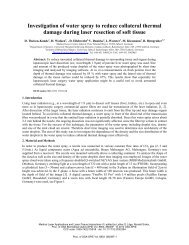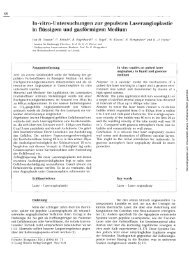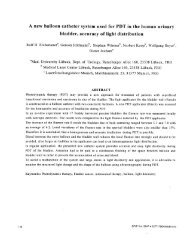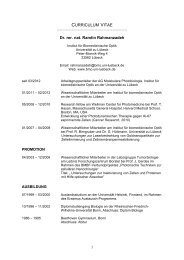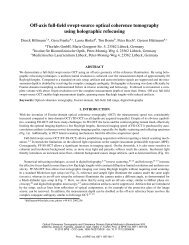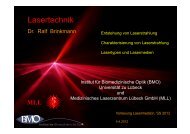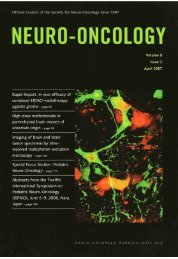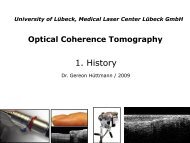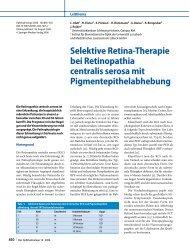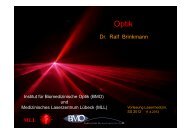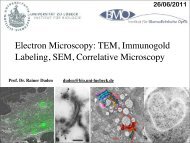1028 Applied Physics B – Lasers and OpticsFIGURE 10 Temperature evolution at the center <strong>of</strong> the <strong>laser</strong> focus producedby a series <strong>of</strong> 800-nm, 100-fs pulses focused into water. (a) 80-MHz repetitionrate, NA = 1.3; (b) 80-MHz repetition rate, NA = 0.6; (c) 1-MHzrepetition rate, NA = 0.6. The volumetric energy density deposited per pulseis always 1 J cm −3 at the focus center. The dashed lines represent thetemperature decay after a single pulse. For comparison, the temperature evolutionduring cw irradiation with the same average power as for the pulsedirradiation is also showndiameter <strong>of</strong> the initial temperature distribution (1/e 2 values)amounts to 336 nm and the length to 806 nm (Sect. 3.2). Figure10 shows the calculated temperature evolution at the center<strong>of</strong> the <strong>laser</strong> focus when series <strong>of</strong> 800-nm, 100-fs pulses arefocused into water at different repetition rates (80 MHz and1MHz) and numerical <strong>aper</strong>tures (NA = 1.3 and NA = 0.6).It was assumed that with each pulse an energy density <strong>of</strong>1Jcm −3 at the center <strong>of</strong> the initial temperature distribution isdeposited. For other values <strong>of</strong> the volumetric energy density,the shape <strong>of</strong> the temperature vs time curve will be the samebut the absolute value <strong>of</strong> the temperature varies proportionallyto the peak density <strong>of</strong> absorbed power, A. For comparison,we also calculated the temperature evolution during cw irradiationwith the same average power as for the pulsed irradiation(dotted lines in Fig. 10a–c). For 80-MHz repetition rate,pulsed and continuous energy deposition differ significantlyonly during the first 100 ns.The calculations in Fig. 10a for tightly focused irradiationwith 80-MHz repetition rate reveal that the temperature is only6.8 times larger after a few microseconds than the temperatureincrease caused by a single pulse. This implies that onlya moderate heat accumulation occurs during plasma-mediatedcell surgery. However, when the numerical <strong>aper</strong>ture is reducedfrom NA = 1.3 to NA = 0.6, such as in Fig. 10b, a 45-foldtemperature increase is predicted. Temperature accumulationcan almost entirely be avoided if, at the same NA, the repetitionrate is lowered to 1MHz(Fig. 10c). In this case, thepeak temperature in a long pulse series is only 1.36 timeslarger than after a single pulse. For 1-MHz repetition rate andNA = 1.3, this factor reduces to 1.024.When <strong>laser</strong> surgery is performed with 80-MHz pulse seriesfocused at NA = 1.3, the boiling temperature <strong>of</strong> 100 ◦ Cwill, due to the 6.8-fold temperature accumulation, be reachedwhen each individual pulse produces a temperature rise <strong>of</strong>11.8 ◦ C (starting from 20 ◦ C room temperature). For 800-nm,100-fs pulses this temperature rise requires a free-electrondensity <strong>of</strong> ϱ c = 2.1 × 10 19 cm −3 , which is reached at an irradiance<strong>of</strong> 0.51 times the value required for optical breakdown(ϱ cr = 10 21 cm −3 ).The temperature distribution in the vicinity <strong>of</strong> the <strong>laser</strong> focusduring application <strong>of</strong> 80-MHz pulse series is presentedin Fig. 11 for different numerical <strong>aper</strong>tures. The distributionarising from the ellipsoidal focus volume is plotted both inradial and axial directions. For NA = 1.3, the temperaturedistribution remains fairly narrow (FWHM ≈ 600 nm) evenafter a few milliseconds when a dynamic equilibrium betweenenergy deposition and heat diffusion has been established.The rapid decrease <strong>of</strong> the temperature with increasing distancefrom the <strong>laser</strong> focus is related to the small size <strong>of</strong> thefocal volume, which allows for rapid heat diffusion in all directions.By contrast, for NA = 0.6 the steady-state temperaturedistribution is more broadened compared to the singlepulsedistribution, in addition to the stronger increase <strong>of</strong> thepeak temperature. Both temperature accumulation and broadening<strong>of</strong> the temperature distribution can be avoided withrepetition rates ≤ 1MHz.At first sight, the results <strong>of</strong> our temperature calculationsmight suggest that an irradiance range below the opticalbreakdown threshold exists where predominantly thermal effectsin biological media can be produced. However, oneneeds to consider that about 10 6 free electrons per pulse aregenerated in the focal volume at the irradiance that createsa temperature difference <strong>of</strong> 11.8 ◦ C per pulse and a peak temperature<strong>of</strong> 100 ◦ C after a pulse series <strong>of</strong> several microseconds(for NA = 1.3). Any thermal denaturation <strong>of</strong> biomoleculeswill thus always be mixed with free-electron-induced chemicaleffects, and the latter will probably dominate.5.3 Comparison with cw irradiation <strong>of</strong> linear absorbersSince various researchers have produced cellularmicroeffects using long-pulsed or continuous-wave irradiation[47, 52, 56, 69–71], it is <strong>of</strong> interest to compare thewidths <strong>of</strong> the temperature distributions produced by series <strong>of</strong>ultra-short <strong>laser</strong> pulses and cw irradiation.Figure 12 shows the evolution <strong>of</strong> the temperature distributionwhen cw irradiation <strong>of</strong> 514-nm wavelength is fo-
VOGEL et al. <strong>Mechanisms</strong> <strong>of</strong> <strong>femtosecond</strong> <strong>laser</strong> <strong>nanosurgery</strong> <strong>of</strong> cells and tissues 1029FIGURE 11 Temperature distribution in radial direction (a, c) and axial direction (b, d) produced by series <strong>of</strong> 800-nm, 100-fs pulses focused into water atnumerical <strong>aper</strong>tures <strong>of</strong> NA = 1.3(a, b)andNA= 0.6(c, d). The pulse-repetition rate was 80 MHz in both cases, and the volumetric energy density depositedat the focus center was 1 J cm −3 for each pulsecused into a linearly absorbing aqueous medium at NA =1.3. The temperature distribution is slightly broader (FWHM850 nm) than that in Fig. 11a arising from nonlinear absorption<strong>of</strong> 80-MHz IR <strong>femtosecond</strong> pulse trains (FWHM600 nm). The temperature distribution produced by <strong>femtosecond</strong>pulse trains is narrower because it originates from thefree-electron distribution (18) rather than from the irradiancedistribution (17) that is relevant for linear energy deposition.However, the spatial resolution <strong>of</strong> <strong>femtosecond</strong> <strong>laser</strong>surgery is not determined by the steady-state temperature distributionbut by the width <strong>of</strong> the free-electron distributionitself, as we shall see in Sect. 7.1. Therefore, the spatial resolution<strong>of</strong> fs <strong>laser</strong> surgery is considerably better than that <strong>of</strong>a cw microbeam.FIGURE 12 Evolution <strong>of</strong> the temperature distribution in radial directionproduced by continuous energy deposition in a linearly absorbing aqueousmedium at a <strong>laser</strong> wavelength <strong>of</strong> 514 nm. The calculations were performedfor the same absorbed average power as in the case <strong>of</strong> pulsed, nonlinearenergy deposition presented in Fig. 116 Thermoelastic stress generationand stress-induced bubble formation6.1 Calculation <strong>of</strong> stress distributionand bubble formationThe temperature rise in the focal volume occursduring thermalization <strong>of</strong> the energy carried by the free electrons,i.e. within a few picoseconds to tens <strong>of</strong> picoseconds(see Sect. 5.1). This time interval is much shorter than theacoustic transit time from the center <strong>of</strong> the focus to its periphery.Therefore, no acoustic relaxation is possible during thethermalization time, and the thermoelastic stresses caused bythe temperature rise stay confined in the focal volume, leadingto a maximum pressure rise [2, 155, 156]. Conservation <strong>of</strong>momentum requires that the stress wave emitted from a finitevolume within an extended medium must contain both compressiveand tensile components such that the integral <strong>of</strong> thestress over time vanishes [155, 157]. The tensile stress wavemay induce fracture <strong>of</strong> the material even after a temperaturerise too small to produce thermal damage [158]. In water, itwill cause the formation <strong>of</strong> a cavitation bubble when the tensilestrength <strong>of</strong> the liquid is exceeded. For cell surgery, thethreshold for bubble formation defines the onset <strong>of</strong> disruptivemechanisms contributing to dissection.To determine the evolution <strong>of</strong> the thermoelastic stress distributionin the vicinity <strong>of</strong> the <strong>laser</strong> focus, we solved the threedimensionalthermoelastic wave equation. A starting point for



